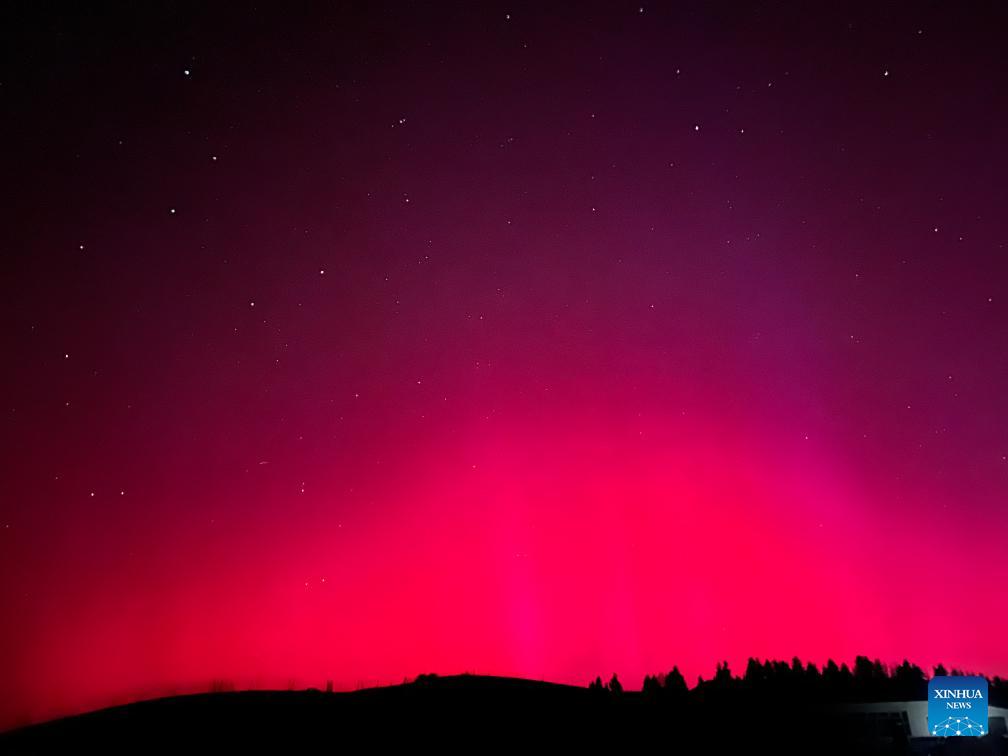Current location:politics >>
China issues alert for geomagnetic storm
politics58People have gathered around
IntroductionThis photo taken with a mobile phone on May 11, 2024 shows the northern lights near Nanshan scenic s ...

This photo taken with a mobile phone on May 11, 2024 shows the northern lights near Nanshan scenic spot in Urumqi, capital of northwest China's Xinjiang Uygur Autonomous Region. [Photo/Xinhua]
China's National Center for Space Weather issued a red alert on Saturday morning after detecting a strong geomagnetic storm that is expected to continue throughout the weekend, which will impact communications and navigation in most areas of the country.
The geomagnetic storm, which began at 11:00 p.m. Beijing Time on Friday, reached its peak with a Kp index of 9, the strongest level, the center said, noting that the storm process was expected to continue in the next 24 hours.
The center warned that the ionosphere in most areas of China will be disturbed by the geomagnetic storm, affecting short-wave communication and navigation, and the increased upper atmosphere density will cause orbital decay for low-orbit satellites.
According to space weather experts, a geomagnetic storm is a phenomenon where the Earth's magnetic field is violently disturbed by high-speed coronal ejection material carrying the sun's magnetic field. The storms can disrupt satellite signals and ground communications, impacting deep space exploration, but generally do not affect human health.
When geomagnetic storms occur, they usually bring with them the phenomenon of auroras. High-energy particles descend from space and collide with the atmosphere, lighting up the sky in different colors.
Due to the current geomagnetic storm, stunning auroras were observed on Friday night and Saturday morning across much of the northern half of China, including Heilongjiang, Inner Mongolia and Xinjiang. Aurora enthusiasts in these regions captured the enchanting dance of light and shadow from the universe with their cameras.
Xiu Lipeng, a member of the Chinese Astronomical Society and an expert in popularizing the science of astronomy, explained that the occurrence of auroras is closely linked to solar activity. The higher the intensity of solar activity, the greater the likelihood of witnessing these marvelous natural phenomena.
The current solar cycle is likely to peak between 2024 and 2025. During this period, solar activity will be very frequent and intense, and the probability of auroral eruptions will be much higher than in normal years, which means that people in northern regions will have more opportunities to see beautiful auroras, Xiu told Xinhua.
Tags:
Reprint:Friends are welcome to share on the Internet, but please indicate the source of the article when reprinting it.“Earthly Exploits news portal”。http://australia.ekjotinstitute.com/article-19e899973.html
Related articles
China's 10th National Public Ice and Snow Season launched
politicsChinese State Councilor Shen Yiqin attends the opening ceremony of China's 10th National Public ...
【politics】
Read moreWorld champions aim to refresh records in Xiamen
politicsWith the 2024 Diamond League just two days away, high jumper Hamish Kerr and discus thrower Laulauga ...
【politics】
Read moreChina Cruise Shipping Conference opens in Shenzhen
politicsThe 16th China Cruise Shipping Conference was unveiled on Saturday in Nanshan district, Shenzhen cit ...
【politics】
Read more
Popular articles
- China makes headway in addressing ship pollution on Yangtze River
- Rape, terror and death at sea: How a boat carrying Rohingya children, women and men capsized
- Lily Allen admits she wants to be buried with her phone so no one will see her 'dark and X
- Hong Kong, mainland self
- CBA Finals: Liaoning ease to comfortable win in Game 1
- Marseille survive Villarreal fightback to go through
Latest articles
Porto fined $1.6M by UEFA and threatened with one
Harper hits grand slam, streaking Phillies rout Blue Jays 10
America's worst jail? Inmate is the THIRD to escape from facility in less than a month
China reclaim Thomas & Uber Cup
How ancient city on Silk Road attracts global fans
Son on target as South Korea beat Thailand 3
LINKS
- Iraq signs MoU with German, U.S. companies on associated gas utilization
- Final survivor of USS Arizona after Pearl Harbor attack dies at 102
- Chengdu Universiade offers 3D
- In pics: World Aquatics Diving World Cup 2023 Super Final
- Chinese border region not affected by radiation source in Russian city: Authorities
- China urges U.S., Japan, Philippines to stop undermining regional peace, stability
- National Fitness Day: Equestrian
- China's State Council to revise, repeal administrative regulations
- Eurozone inflation further cools in March
- Xizang chairman hails region's miraculous development